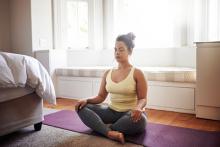
Mindful meditation is the practice of learning to focus fully on the present moment. This simple practice requires effort and discipline because it is the mind’s nature to wander, vacillating between what happened in the past (and the meaning we make of those experiences) and what we want to happen in the future (including our to-do lists, goals, and plans). Mindful meditation is a way to become aware of the habits of the mind—with openness and curiosity instead of judgment.
To live a meaningful life, we need to feel in control of our responses and trust in our own ability to behave in ways that have integrity and bring happiness. Victor Frankl, a physiologist and Holocaust survivor, writes in Man’s Search for Meaning, “Between stimulus and response, there is a space. In that space is our power to choose our response. In our response lies our growth and our freedom.”
When someone cuts us off in traffic or drives in a way that we find reckless (stimulus), the event can trigger a response. When we feel threatened, even in seemingly small ways, our limbic brain (driven by survival) typically takes over. Without thinking, we can react to the stimulus with anger or rage, behaving in ways that are driven by those feelings instead of by the freedom of choice. By contrast, if we can learn to carve out just a moment of space after that stimulus, we can feel the anger in our body and choose our response to be driven by our own personal power, integrity, and freedom.
Mindful meditation helps us grow that space between stimulus and response. The practice slows down the flash reactions that otherwise erupt in our daily lives. We should enter into this practice with no agenda, simply sitting with, and holding space for, our experience.
Step #1
The first step is to find a position in which you feel relaxed and alert. Beginners may feel comfortable lying on the floor with blankets, bolsters, or yoga mats. An eye covering may also be grounding, as it further removes the stimulus of light.
Step #2
When sitting on a folded blanket or meditation cushion, the spine should be aligned: shoulders over hips, ears over shoulders, chin parallel with the floor, and hips positioned high enough so that the knees can relax toward the floor. Then, settle in and find an anchor in the present moment. I prefer to focus on the breath, to notice the sensation of the inhalation, the exhalation, and the space in between. As you sit, just notice whatever arises.
Step #3
Once you are comfortable and have connected with an anchor in the present moment, there is actually nothing else to do. The practice is just to be, with awareness in the present moment, without judgment. Inevitably, your mind will wander. When this happens, label your thoughts—saying “thinking” to yourself is one method—and return to the sensation of breathing. By reconnecting to your breath, you can again sit in the role of the observer, witnessing the moments move by. When distractions arise, you gently touch the thought or feeling by labeling it and return again to the moment.
A helpful analogy is to see your clear mind as the bright blue sky and the thoughts that pass by as puffy white clouds. Sometimes you drift for a while on a cozy cloud. Sometimes you notice a white cloud but can still see the clear blue sky.
Being Instead of Doing
Many of my students are surprised at how difficult it can be to sit for even a few minutes in mindful meditation. Noticing how the mind jumps from thought to thought can seem overwhelming. Give yourself permission to have a sense of humor at the monkey mind jumping around in your head: “Wow, it’s so busy!”
Try to sit or recline for 5–10 minutes. Then, let it go and try again another day. Use soft, relaxing music if that helps. Or try guided meditations from YouTube or a CD. Let go of the pressure to do it “right.”
Mindful meditation is kind of like doing bicep curls for your brain. Slowly, you become stronger at returning to the present moment. Your mind wanders and you help it return. You practice being instead of doing. Over time, you see more clearly what is really happening in the present moment and are no longer a slave to impulses and habitual patterns. You really can find space and freedom and ease just by learning how to settle into your own mind.




